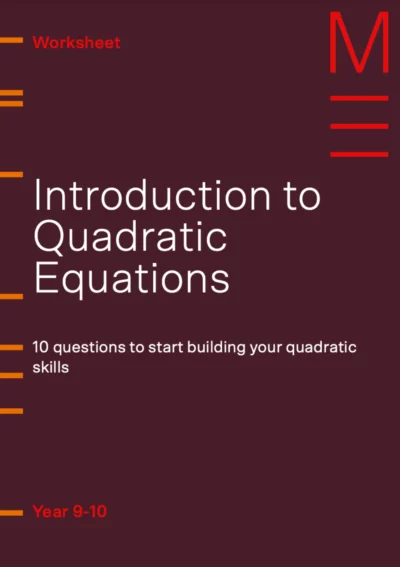Welcome to Matrix Education
To ensure we are showing you the most relevant content, please select your location below.
Select a year to see courses
Learn online or on-campus during the term or school holidays
Learn online or on-campus during the term or school holidays
Learn online or on-campus during the term or school holidays
Learn online or on-campus during the term or school holidays
Learn online or on-campus during the term or school holidays
Learn online or on-campus during the term or school holidays
Learn online or on-campus during the term or school holidays
Learn online or on-campus during the term or school holidays
Learn online or on-campus during the term or school holidays
Learn online or on-campus during the term or school holidays
Select a year to see available courses
Science guides to help you get ahead
Science guides to help you get ahead
In this article, the Matrix Maths team breaks down the essential techniques for solving quadratic equations. Learn the four key methods—factorisation, the cross method, completing the square, and the quadratic formula!

Join 75,893 students who already have a head start.
"*" indicates required fields
Related courses

Join 8000+ students each term who already have a head start on their school academic journey.
Quadratic equations are an important part of high school Maths, especially as you progress in algebra. Whether you’re prepping for tests or want to improve your skills, learning different methods to solve quadratic equations will give you an advantage.
This guide covers four key methods, plus a free download of 10 practice questions to help you get better!
Quadratic equations are introduced in Year 9 and explored in more depth in Year 10. Building a strong understanding early will give you a head start and make advanced topics much easier.
According to the NSW Stage 5.3 syllabus, students should be able to:
According the the syllabus, by the end of this topic you’ll be able to:
A quadratic equation is any equation where the highest power of the variable (typically \( x \)) is 2.
The general form of a quadratic equation looks like this:
Where:
In simpler terms, quadratic equations involve a variable that is squared (raised to the power of 2). Some examples include:
\( x^2\)
\(z^2 + 5z\)
\(3x^2 – 10x + 7 \)
Before you tackle quadratic equations, make sure you’re familiar with these algebraic basics:
Want to get ahead in Maths?
Learn with expert teachers and proven resources. See why 8,000+ students enrol each term.
Quadratic equations can be solved using 4 main methods:
A monic quadratic trinomial is expressed in the form: \( ax^2+bx+c\) where the coefficient \( a=1\).
In this method, you are expanding: \( (x + a)(x + b) = ax^2 + (a + b)x + ab \)
So, to factorise a monic quadratic trinomial, you need to reverse the process by finding 2 numbers whose:
For example:
You need to find two numbers that:
The numbers are 2 and -4. So, you factorise it as:
So,
or
A non-monic quadratic trinomial is expressed as:
\( ax^2 + bx + c \)
where the coefficient \( a \neq 1 \).
Step 1: Set up a workspace as shown:
Step 2: Choose numbers for the circles that multiply to = the quadratic term (the product should be equal to \( ax^2\) ).
Step 3: Choose numbers for the squares that multiply to = the constant term.
Hint: set up and align the factors/numbers vertically.
Step 4: Select the numbers so that when cross-multiplying in the indicated directions, the results: sum of coefficient = linear coefficient!
Step 5: Write the numbers from the circles and squares horizontally to get the two factors of the trinomial expression.
Example: Solve the quadratic equation \( 2x^2 + x – 3 = 0 \)
Set up the workspace and start filling in:
Align factors vertically and find:
Cross multiply and check the sum of the coefficient results:
\( 3x + (-2x) = x \) (linear coefficient!)
Hint: Write factors horizontally, from the 1st and 2nd row, outlined in orange and green lines, respectively.
Hence,
\( 2x^2 + x – 3 = (2x + 3)(x – 1) \).
\( (2x + 3)(x – 1) = 0 \)
Therefore, \( x = \frac{-3}{2} \text{ or } x = 1 \)
Note: Sometimes, before factorising, you need to extract the Highest Common Factor (HCF) to simplify the quadratic trinomial.
Example:
The HCF is 3, so we factor it out first:
Then, we factorise the remaining quadratic:
Completing the square rearranges a quadratic equation into a perfect square trinomial (a squared binomial). This allows us to solve for \( x \) by square-rooting both sides.
\( (a \pm b)^2 = a^2 \pm 2ab + b^2 \)
To factorise by completing the square:
To complete the square for \( ax^2 + bx + c \) (where a=1):
\( x^2 + bx + \frac{b^2}{4} – \frac{b^2}{4} + c \) \( = \left( x + \frac{b}{2} \right)^2 – \frac{b^2}{4} + c \)
Example: Solve \( x^2 + 6x + 1 \):
\( (x + 3)^2 – 8 = 0 \)
\( (x + 3)^2 = 8 \)
\( x + 3 = \pm 2\sqrt{2} \)
\( x = \pm 2\sqrt{2} – 3 \)
Note: Ensure quadratic coefficient = 1 (monic)
To factorise non-monic, divide through by coefficient of \( x ^2 \)
Examples: \( 2x^2 – 4x = 5 \) can be rewritten as \( x^2 – 2x – \frac{5}{2} = 0 \)
When a quadratic equation can’t be factorised, or if completing the square seems too tricky, use the Quadratic Formula.
This formula works for all quadratic equations:
\( x = \frac{-b \pm \sqrt{b^2 – 4ac}}{2a} \)
Apply the formula by substituting variables: \( ax^2 + bx + c \)
Example:
Solve the quadratic equation: \( x^2 + 6x + 2 = 0 \).
a = 1, b = 6, c = 2
2. Substitute these values into the quadratic formula.
\( x = \frac{-6 \pm \sqrt{(6)^2 – 4(1)(2)}}{2(1)} \)
\( x = \frac{-6 \pm \sqrt{36 – 8}}{2} \)
\( x = -3 \pm \sqrt{7} \)
Solve, expand, and master quadratics with this Year 9 worksheet! Fill out your details below to get this resource emailed to you. "*" indicates required fields
Get ahead in quadratic equations!

Get ahead in quadratic equations!
Written by Matrix Maths Team
The Matrix Maths Team are tutors and teachers with a passion for Mathematics and a dedication to seeing Matrix Students achieving their academic goals.© Matrix Education and www.matrix.edu.au, 2025. Unauthorised use and/or duplication of this material without express and written permission from this site’s author and/or owner is strictly prohibited. Excerpts and links may be used, provided that full and clear credit is given to Matrix Education and www.matrix.edu.au with appropriate and specific direction to the original content.